Starting from the beginning, precision cure -the 5th Chinese breast cancer precision treatment summit forum · Surgery
Author:Cancer Channel of the Medical Time:2022.06.15
*For medical professionals for reading reference

The new auxiliary strategy adds to the precise treatment of early breast cancer, while the multi -department -close -up collaboration of Chinese surgery develops and how to further improve the benefits of patients.
Surgical treatment of early breast cancer is an indispensable local treatment of breast cancer treatment. With the revolutionary progress of targeted drugs to promote new assisted therapy, the new auxiliary strategy has opened a new era of precision treatment of early breast cancer. On the afternoon of June 11, the 5th China Breast Cancer Precision Treatment Summit Forum · Surgical Specialty kicked off.
Professor Shao Zhimin, a special surgery, Professor Ren Guosheng, Ren Guosheng, Professor Ren Guosheng, and Professor Wu Yan, the First Affiliated Hospital of Chongqing Medical University, and co -chairman of the conference.
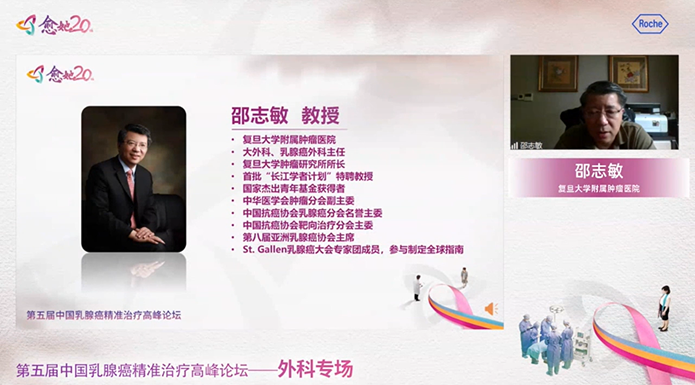
Professor Shao Zhimin of the Cancer Hospital Affiliated to Fudan University delivered a speech
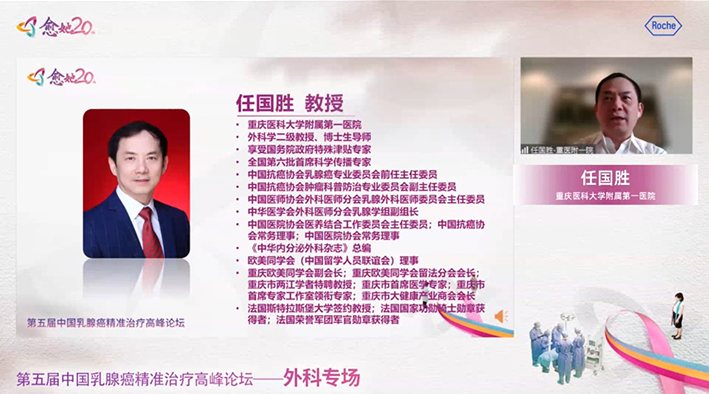
Professor Ren Guosheng, the First Affiliated Hospital of Chongqing Medical University, delivered a speech

Professor Wu Yan of Fudan University Affiliated Oncology Hospital Speed speech
Cross -domain collaboration, multi -angle to help discipline construction
In this session, Professor Zhang Jin of Tianjin Medical University Cancer Hospital, Professor Liu Yunjiang of Hebei Medical University Fourth Hospital, and Professor Liu Qiang of Sun Yixian Memorial Hospital of Sun Yat -sen University were co -host. Professor Chen Yingding of the Second Hospital of Zhejiang University and Professor Wang Xi of the Sun Yat -sen University Tumor Prevention Center shared the practice of the MDT diagnosis and treatment model of their respective hospitals. Professor Chen Yiding emphasized that new assisted therapy is the first step in the cure for patients with HER2+early breast cancer. The diagnosis and treatment is achieved by new assisted treatment, so as to achieve early cure for patients. The evaluation of science can not only optimize the surgical plan, shorten the waiting time during the operation, but also accurately screen people who are suitable for new assisted treatment, and optimize the early system treatment plan. The hospital shortened the waiting time of patients through process optimization, strengthening department collaboration, establishment of green channels, and so on. While speeding up the waiting time of patients, treatment decisions were accelerated to better promote the scientific management of breast cancer. Professor Wang Xi reviewed the history and results of exploring the MDT model, and proposed that the diagnosis and treatment of breast cancer MDT is still to be optimized. Looking forward to building a "precise diagnosis and treatment+full management" treatment model to bring more benefits to patients.
Next was chaired by Professor Liu Qiang, Professor Yang Shengsheng of Gansu Cancer Hospital, Professor Fu Peifen, First Affiliated Hospital of Zhejiang University, Professor Wang Shouman, Xiangya Hospital of Central South University, and Professor Liu Yueping, Hebei Hospital of Hebei Hospital, as guests. "Multi -disciplinary diagnosis and treatment center construction experience sharing" launched a super interview. The topic covers "How to balance the interests of different departments in MDT construction, and promote the standards and processes of standard diagnosis and treatment of various disciplines", "what benefits of the breast conventional MDT bring to the patient, and in the early breast cancer, which types of patients will consider incorporating income into "MDT category", "What is the biggest obstacle encountered in the construction of mdt MDT and what is the valuable experience you get", "How to promote the smooth flow of the newly -supported process by strengthening the cooperation of pathology and clinical departments in MDT Essence Four professors from different hospitals in different regions have made a very instructive opinion based on the setting of the hospital and their own experience. Although it is not yet possible to homogeneous breast cancer MDT, each hospital is strengthening the inter -departmental collaboration through different ways. Promoting the improvement of breast cancer diagnosis and treatment will continue to work hard in the future.
The progress of Chinese and foreign talks, the preferred solution has more benefits
The host of this link is Professor Wang Haibo, Affiliated Hospital of Qingdao University, Professor Liu Zhenzhen of Henan Cancer Hospital, and Professor Yu Kenda, a affiliated oncology hospital affiliated to Fudan University.
German Practice: New Auxiliary Treatment Preferred Plan is expected in the future
Professor Nadia Harbeck from the LMU University Affiliated Hospital of Germany conducted a keynote speech entitled "Her2+ Early Breast Cancer Trend and Clinical Practice of Neoadjuvant Therapy" and shared the German management model of management models). And practical experience. Professor NADIA Harbeck proposed that the NEOSPHERE -based research Herpa dual targets (Tuskomo Mippot combined Puffy Mipoly) achieved PCR (Pathologic Complete Response). At 18-24 weeks before the operation, the chemotherapy combined with the Herpa dual-target scheme for new assisted treatment, and multi-disciplinary coordinated management should run through the whole process. The timing and method of surgery shall be individually designed according to the tumor load and the response to the treatment. Patients with a large tumor load before the treatment of neo -assisted treatment still have a certain risk of recurrence even after reaching the PCR after treatment. Therefore, it is recommended to continue to treat the Hipa dual -target scheme in the next year. T-DM1 treatment. In the future, the promotion and level of new assisted treatment may bring new breakthroughs to the treatment of breast cancer. Preliminary research has already been tips. The new auxiliary solution of the paclitaxel combined with Herpa dual -target is one of the best solutions to reduce chemotherapy. It is also an optional solution for T-DM1 to be upgraded to T-DM1, but the above progress is limited to HER2 high-sensitive tumors. However, there is no doubt that the treatment of the preferred plan will benefit early breast cancer patients, and it will bring more in the future. Professor Nadia Harbeck, Affiliated Hospital of LMU University
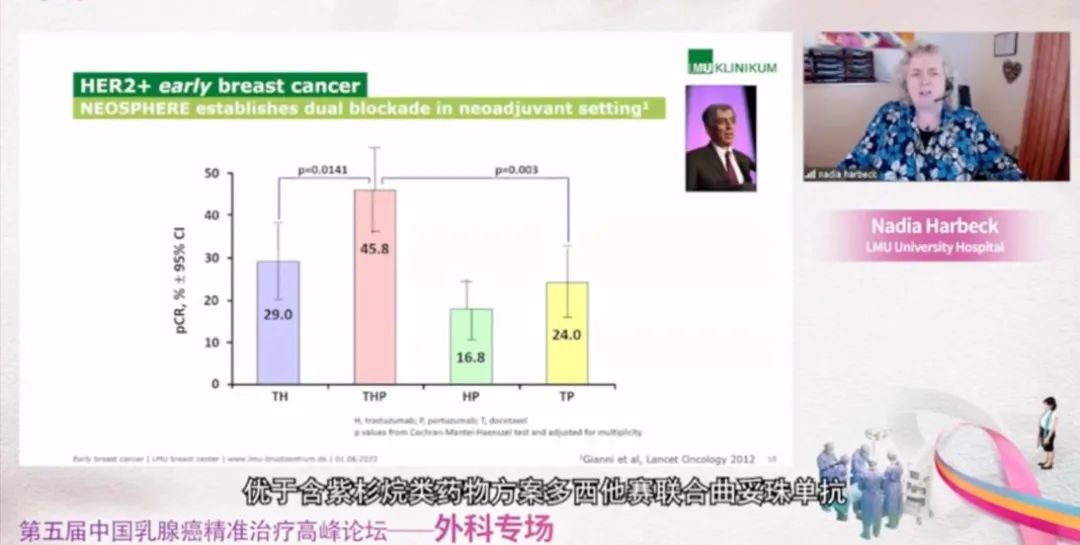

China Practice: Protestant therapy Optical Optional Plan is continuously verified and expanded
Professor Wang Shu of the People's Hospital of Peking University shared the "HER2+New Auxiliary Treatment Practice and Exploration of Breast Cancer". With the continuous development of research, the goal of new auxiliary treatment of breast cancer has gradually gradually developed from surgery, milk -keeping armpit, and guidance to guidance to guidance to guidance Subsequent treatment has improved the long -term prognosis, and this change is particularly prominent in the type of HER2+breast cancer. The NEOSPHERE study results reminded that the TPCR of Herpa dual -target new auxiliary treatment is 39.3. In HR+HER2+crowd, Herpa dual -target new assisted treatment of TPCR is more than 46%, while the 5 -year data analysis results of NeoSphere studied show that although it has not reached significant statistical statistics, although it has not reached significant statistics Differential, but the 5-year DFS rate (Disease-Free Survival, an invasive disease survival rate) is higher. On the basis of Hipa's dual target, combined with other powerful chemotherapy drugs PCR will be further improved (& 50%) and eventually transform into long -term survival benefits. The plan provides patients with maximum healing opportunities. Other neo -auxiliary treatment solutions based on Herpa dual targets are still expanding. The joint scheme announced with the PD-L1 on the 2021ESMO obtained a higher PCR, Neoalto Study in the Neoalto Study of Two Ming and TKI (Tyrosine Kinase Inchibitor, Tyhnase Inhibitors) Laputininib. The PCR rate reached during the treatment phase is more than twice as much as the Lapatinib single drug group (51.3% vs.24.7%), but unfortunately the subsequent Altto research results indicate that its auxiliary treatment stage has not converted the high PCR rate into long -term survival for a long time. Benefit. Therefore, the Herpa dual -target solution that can help patients can reach PCR and can be transformed into long -term survival benefits at the neo -assistant stage is still a preferred plan in clinical practice.
Long -term survival benefits are closely related to the selection of the auxiliary schemes after new assisted treatment, and the selection of the auxiliary schemes needs to be PCR combined with accurate pathological assessment results. A real -world study published in 2021 prompts that the PCR population continuous dual -target auxiliary treatment is achieved after using the Herpa dual -target solution for new assistance. Compared with the single target scheme, the single target scheme is significantly benefited from IDFS. Katherine studies have proved that patients with residual lesions (NON-PCR) after neo-assisted treatment, regardless of hormone receptor and lymph node status, T-DM1 can significantly improve IDFS compared to single target schemes. Based on this, after new assistive treatment Non-PCR patients are recommended to use T-DM1 at home and abroad. At present, new plans such as HER2+early breast cancer reduction de -chemotherapy schemes, precise auxiliary upgrade paths, etc. are all being explored. In the future, as systemic treatment is richer, surgical treatment is becoming more and more accurate, and more patients have reached long -term long -term Benefits for survival.
Professor Wang Shu of Peking University People's Hospital report
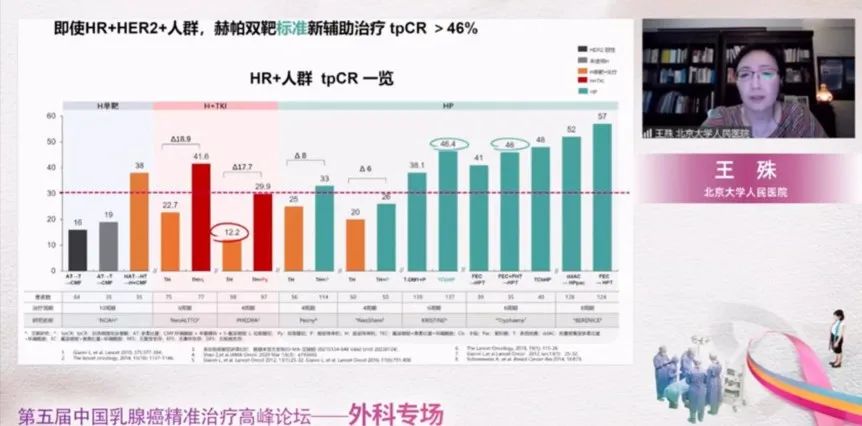
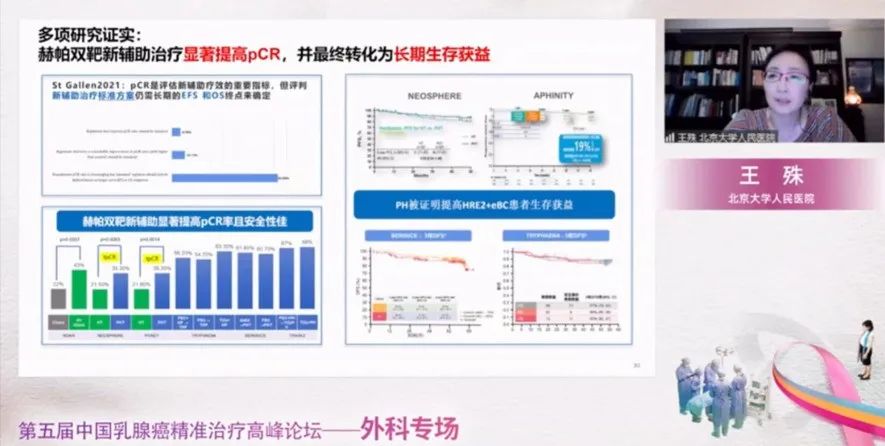
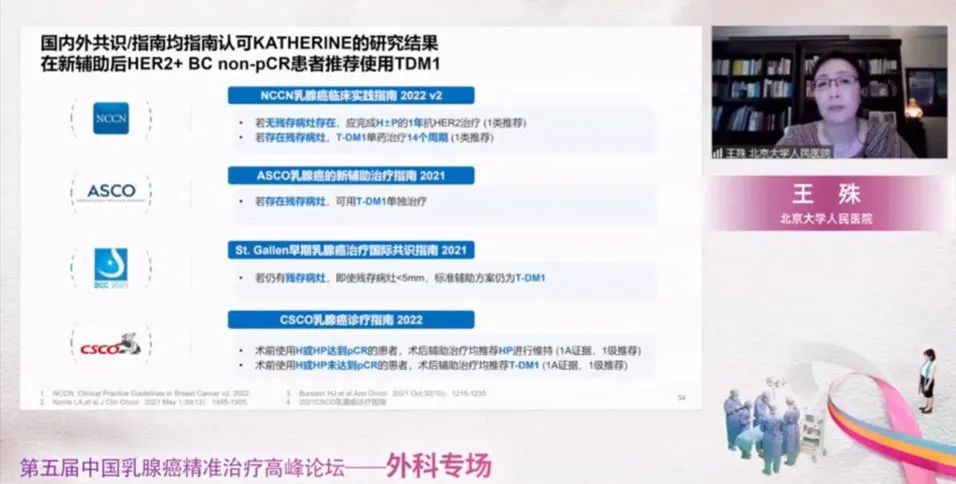
China Thinking: Optical Plan Practice Real Knowledge
Professor Yu Kenda presided over a super interview entitled "New Auxiliary Chinese and Foreign Dialogue Hot Discussion". The interviewed guests were Professor Xu Yingying, the First Affiliated Hospital of China Medical University, Professor Fan Zhaoqing of Peking University Cancer Hospital, Professor Wang Ting, Xijing Hospital of Air Force Military Medical University, Guangdong Professor Xu Rui, the University of Traditional Chinese Medicine University. The topic includes "whether the newly -assisted preferred population is recommended for new assisted treatment or other factors will be considered." Whether the therapy can be replaced with homogeneity "," the international research hotspots and the efforts of Chinese experts in the treatment of new assisted therapy. " Among them, the second topic about the choice of clinical solutions has triggered a lively discussion. In view of the expected the highest PCR rate and the maximum effect of newly -assisted therapy, the HER2+patient scheme recommends the conventional Hipa dual -target scheme, but whether it is auxiliary therapy In the continuous application, guests and hosts have made profound opinions based on clinical practice and research data. Professor Xu Yingying: Choosing homogeneous scheme (paclitaxel+platinum+Herpa dual target scheme runs through new assisted therapy to auxiliary therapy) clinical operation is more convenient, and it also means higher PCR rate, more controllable adverse reactions The situation, as well as fewer people who intervene in the later period.
Professor Fan Zhaoqing: At present, the plan for choosing paclitaxel+platinum+Herpa dual target is lower than the rings schemes to the heart toxicity, and patients with insufficient anti-tumor effect can also be upgraded to a candidate scheme such as T-DM1. In addition Its curative effect is not inferior to the cyclic ring scheme. Therefore, it is the preferred plan in neo -assisted treatment, but at present, the number of evidence in terms of auxiliary treatment is still insufficient. I hope that there can be more sufficient evidence -based evidence in the future.
Professor Wang Ting: It is more inclined to facilitate the homogeneity scheme of operation, but the choice of the plan is not absolute. For example, for patients with low platelets, the adverse reactions of platinum will further reduce platelets. Because waiting for the test results for too long, such situations will also choose heterogeneity solutions.
Professor Xu Rui agrees with Professor Fan Zhaoqing's thoughts, and is more inclined to choose more heterogeneous solutions with more clinical data. He also looks forward to more evidence -based data support for homogeneous schemes.
Professor Yu Keida agreed with the opinions of many parties, saying that the guide was recommended to both plans. In the influence of the guests, the guests were considering the influencing factors of the guests, and it also hoped that more evidence -based data would continue to consolidate the foundation of clinical practice in the future.
Host and expert discussions with experts and experts
Exquisite surgical skills, improve high quality survival
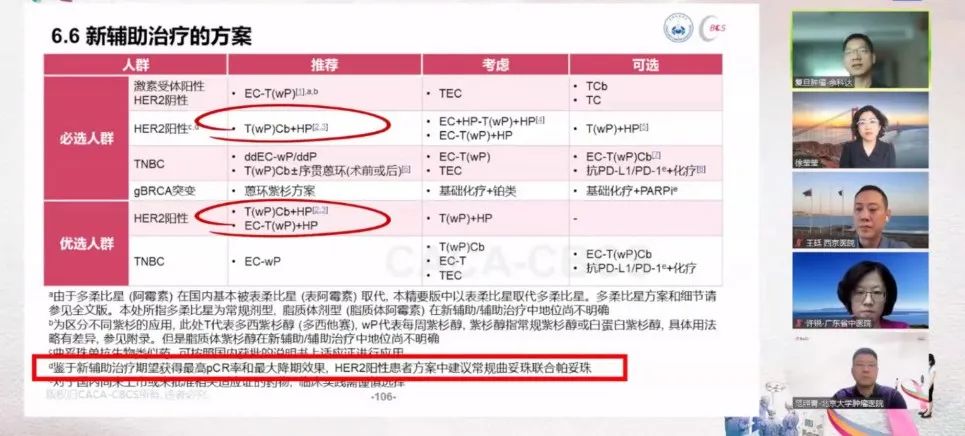
In this session, Professor Wang Yongsheng of Shandong Cancer Hospital, Professor Jin Feng of the First Affiliated Hospital of China Medical University, Professor Fan Zhimin of the First Hospital of Jilin University, and Professor Liu Xiao'an of Jiangsu Provincial People's Hospital were co -chaired.
Professor Wang Kun, Guangdong Provincial People's Hospital, gave a keynote speech on "New Auxiliary Treatment Decreasing Breasts and Axillary Preservation", put forward the foundation of the progress of new auxiliary system treatment for the milk protection after the treatment of new assisted treatment, and reduced the local recurrence of local recurrence Risk, but precise tumor bed positioning is required before new assisted treatment, and precision prediction of tumor retracting mode is equally important. For patients with PCR, a single disease can be considered "no ink on tumor" And multi -lesions are recommended to remove the scope before the new assisted treatment.
By the lecture, the remaining heat did not disappear, and Professor Fan Zhimin hosted a super interview around "the new assisted treatment of the hot spot of the axillary armpit after treatment." The guests include Professor Lin Ying, the First Affiliated Hospital of Sun Yat -sen University, Professor Li Xingrui, Tongji Hospital affiliated to Tongji Medical College of Huazhong University of Science and Technology, Professor Cha Xiaoming, Jiangsu People's Hospital, Professor Qi Xiaowei of Southwest Hospital of the Army Medical University, and Professor Yang Huawei of the Cancer Hospital affiliated to Guangxi Medical University. Discussion topics include "patients who intend to pass the auxiliary guarantee milk protection armpit, the number of marks required before the treatment before treatment", "the scope of the removal of breast protection surgery after new assisted treatment" "Standard of Fate". Experts combined with Professor Wang Kun's speech content to express their opinions on the specific operations before and after the treatment of neo -assisted treatment. In the end, they all benefited from greater patients.
Subsequently, Professor Li Hongyuan, the First Affiliated Hospital of Chongqing Medical University, shared the "Selection of Tumor Plastic Surgery and Reconstruction and Reconstruction". Firstly, the changes in breast cancer surgery were reviewed. The shape of the breast, size, etc., choose different tumor plastic surgery and breast reconstruction, and the pre -operative incision design, the blood supply of the dermis, the width of the upper and lower tideline is the key to tumor plastic surgery. Freshy, departure range, symmetry, and blood supply of the skin, etc.
Immediately, Professor Liu Xiaoan presided over a super interview with "tumor plastic surgery and reconstruction hotspot issues". The guests including Professor Wang Xin, Professor Wang Xin, Professor Wang Xin, Professor Li Yongqing of Shandong Cancer Hospital, Professor Zhang Qiang of Liaoning Cancer Hospital, and Professor Zhang Qiang of the Shandong Cancer Hospital. Professor Rao Nanyan, Sun Yixian Memorial Hospital of Sun Yat-sen University, covers the topic "Decisions for tumor plastic surgery and breast reconstruction to formulate high-risk factors". The relationship between resection) and plastic surgery and milk -keeping surgery "," expander replacement of prosthesis before or after radiotherapy is performed, how to consider this problem for patients to formulate the best strategy "," prosthetic breast reconstruction and How to choose from autologous breast reconstruction. " Experts gave considerations to the results of specific issues and their own experience, and Professor Liu Xiaoan fully summarized and supplemented. Summarize
The conference ended in a strong academic atmosphere. Through the discussion of hot topics, experts expressed their knowledge based on clinical practice and detailed data, and collided with wisdom sparks. As an important component of the comprehensive treatment of early breast cancer, surgical treatment still has room for further optimization in the application strategy, application timing, and cooperation with other disciplines in multidisciplinary diagnosis and treatment. Surgical treatment will optimize her journey to more breast cancer patients and bring bright new life.
Scan poster QR code
Watch the meeting back
*This article is only used to provide scientific information to medical people, and does not represent the viewpoint of this platform
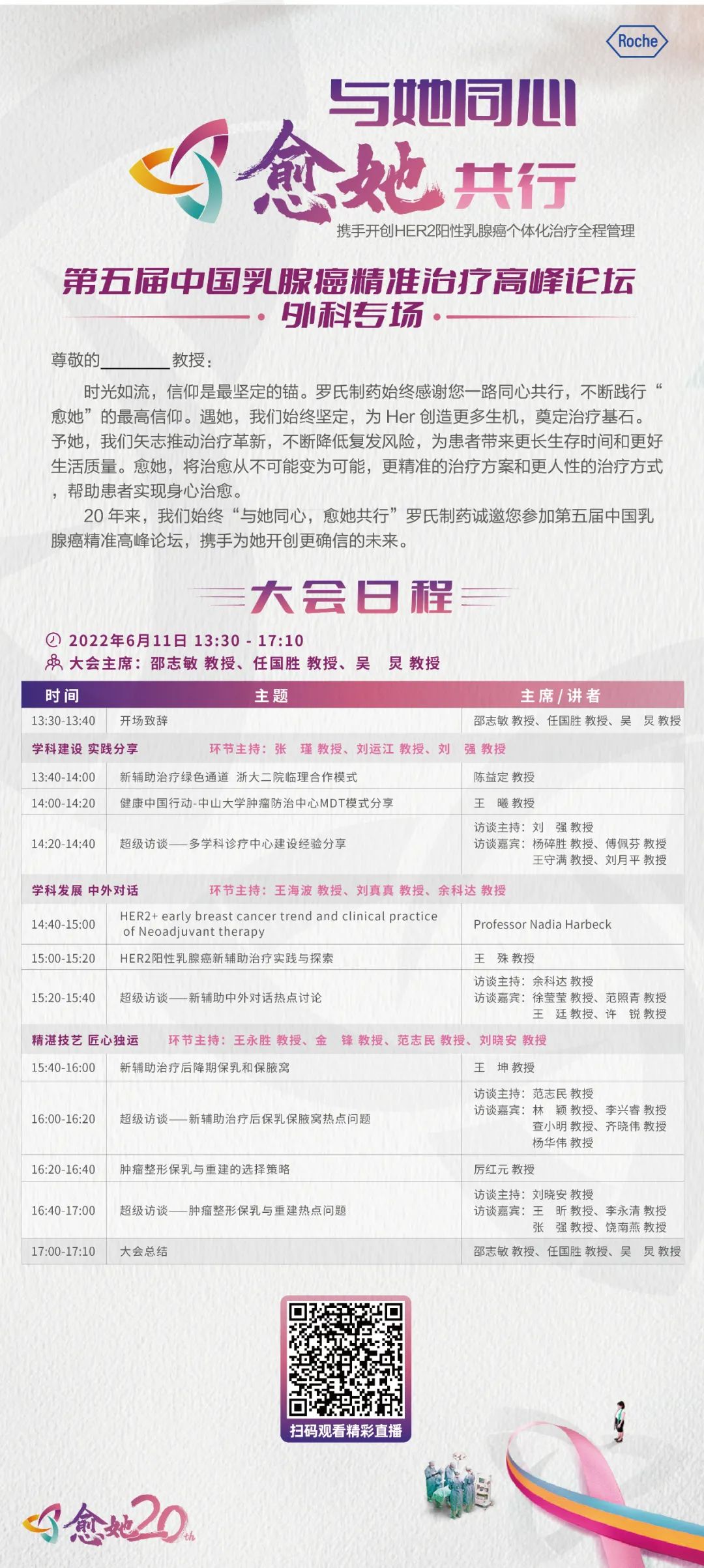


- END -
Muzhi: China's ancient glazed aesthetics and collection

Chinese ancient glazed aesthetics and collectionPastoral(Founder of China Liuli.co...
Dingyang Muyun, the summer evening Jiadingmei came out of the sky →

These evening Jiading, the sky seemed to be overturned, and the setting sun was as...